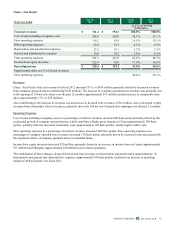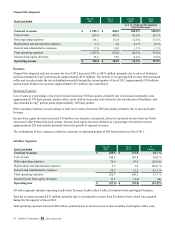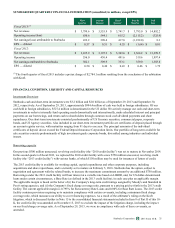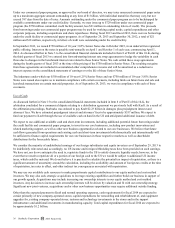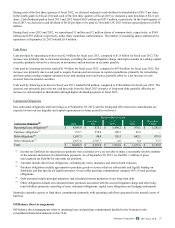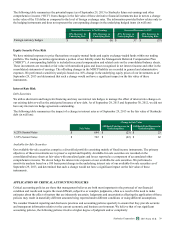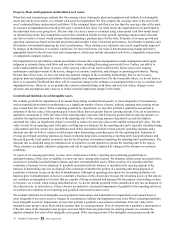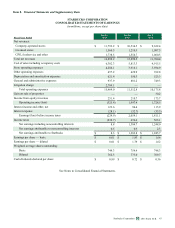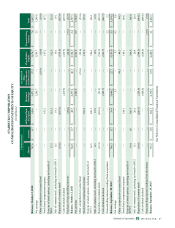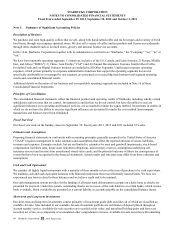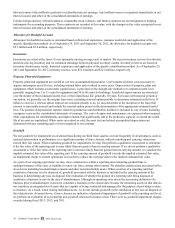Starbucks 2013 Annual Report Download - page 48
Download and view the complete annual report
Please find page 48 of the 2013 Starbucks annual report below. You can navigate through the pages in the report by either clicking on the pages listed below, or by using the keyword search tool below to find specific information within the annual report.
40
Property, Plant and Equipment and Definite-Lived Assets
When facts and circumstances indicate that the carrying values of property plant and equipment and definite-lived intangible
assets may not be recoverable, we evaluate such assets for impairment. We first compare the carrying value of the asset to the
asset’s estimated future undiscounted cash flows. If the estimated future cash flows are less than the carrying value of the asset,
we measure an impairment loss based on the asset’s estimated fair value. For retail assets, the impairment test is performed at
the individual store asset group level. The fair value of a store’s assets is estimated using a discounted cash flow model based
on internal projections. Key assumptions used in this calculation include revenue growth, operating expenses and a discount
rate that we believe a buyer would assume when determining a purchase price for the store. Estimates of revenue growth and
operating expenses are based on internal projections and consider a store’s historical performance, local market economics and
the business environment impacting the store’s performance. These estimates are subjective and can be significantly impacted
by changes in the business or economic conditions. For non-retail assets, fair value is determined using an approach that is
appropriate based on the relevant facts and circumstances, which may include discounted cash flows, comparable transactions,
or comparable company analyses.
Our impairment loss calculations contain uncertainties because they require management to make assumptions and to apply
judgment to estimate future cash flows and asset fair values, including forecasting asset useful lives. Further, our ability to
realize undiscounted cash flows in excess of the carrying values of our assets is affected by factors such as the ongoing
maintenance and improvement of the assets, changes in economic conditions, and changes in operating performance. During
the past three fiscal years, we have not made any material changes in the accounting methodology that we use to assess
property plant and equipment and definite-lived intangible asset impairment loss. For the foreseeable future, we do not believe
there is a reasonable likelihood that there will be a material change in the estimates or assumptions that we use to calculate such
impairment losses. However, as we periodically reassess estimated future cash flows and asset fair values, changes in our
estimates and assumptions may cause us to realize material impairment charges in the future.
Goodwill and Indefinite-Lived Intangible Assets
We evaluate goodwill for impairment on an annual basis during our third fiscal quarter, or more frequently if circumstances,
such as material deterioration in performance or a significant number of store closures, indicate reporting unit carrying values
may exceed their fair values. When evaluating goodwill for impairment, we may first perform a qualitative assessment to
determine if the fair value of the reporting unit is more likely than not greater than its carrying amount. If we do not perform a
qualitative assessment or if the fair value of the reporting unit is not more likely than not greater than its carrying amount, we
calculate the implied estimated fair value of the reporting unit. If the carrying amount of goodwill exceeds the implied
estimated fair value, an impairment charge is recorded to reduce the carrying value to the implied estimated fair value. The fair
value of each of our reporting units is the price a willing buyer would pay for the reporting unit and is typically calculated using
a discounted cash flow model. Key assumptions used in this calculation include revenue growth, operating expenses and a
discount rate that we believe a buyer would assume when determining a purchase price for the reporting unit. Estimates of
revenue growth and operating expenses are based on internal projections considering a reporting unit’s past performance and
forecasted growth, local market economics and the local business environment impacting the reporting unit’s performance. The
discount rate is calculated using an estimated cost of capital for a retail operator to operate the reporting unit in the region.
These estimates are highly subjective judgments and can be significantly impacted by changes in the business or economic
conditions.
As a part of our ongoing operations, we may close certain stores within a reporting unit containing goodwill due to
underperformance of the store or inability to renew our lease, among other reasons. We abandon certain assets associated with a
closed store including leasehold improvements and other non-transferable assets. When a portion of a reporting unit that
constitutes a business is to be disposed of, goodwill associated with the business is included in the carrying amount of the
business in determining any loss on disposal. Our evaluation of whether the portion of a reporting unit being disposed of
constitutes a business occurs on the date of abandonment. Although an operating store meets the accounting definition of a
business prior to abandonment, it does not constitute a business on the closure date because the remaining assets on that date do
not constitute an integrated set of assets that are capable of being conducted and managed for the purpose of providing a return
to investors. As a result, when closing individual stores, we do not include goodwill in the calculation of any loss on disposal of
the related assets. As noted above, if store closures are indicative of potential impairment of goodwill at the reporting unit level,
we perform an evaluation of our reporting unit goodwill when such closures occur.
We evaluate indefinite-lived intangible assets (primarily trade names and trademarks) for impairment on an annual basis or
more frequently if an event occurs or changes in circumstances indicate that impairment may exist. When evaluating indefinite-
lived intangible assets for impairment, we may first perform a qualitative assessment to determine if the fair value of the
intangible asset group is more likely than not greater than its carrying amount. If we do not perform a qualitative assessment or
if the fair value of the intangible asset group is not more likely than not greater than its carrying amount, we calculate the
implied estimated fair value of the intangible asset group. If the carrying amount of the intangible asset group exceeds the
2013 10-K
Starbucks Corporation Form





